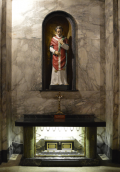St Valentine and St Cyril and Methodius

St Valentine
Two early Christian martyrs called Valentine are listed on this day in the Roman Martyrology. One was a Roman priest, who died for his faith on the Flaminian Way under Claudius II. The other was a bishop of Terni who was killed in Rome. Some historians believe they are the same person.
There is no evidence to link the tradition of sending Valentine cards with the saint - but according to legend, St Valentine sent a farewell message to his jailer's daughter the day before he was executed, signed 'from your Valentine'. Some believe the custom grew out of an ancient idea that birds are supposed to begin their courtship on this day. Others point to the fact that the old Roman Lupercalia festival (in honour of the god of fertility, Lupercus) was held around the middle of February.
The idea of sending cards and love letters on February 14 is at least as old as Chaucer and was mentioned in the 15th century Paston family letters. There are no churches in England dedicated to St Valentine, but churches in Ireland and Scotland have links with the saint.
In 1836, some relics that were exhumed from the catacombs of Saint Hippolytus on the Via Tiburtina, then near Rome, were identified with Saint Valentine. These relics were placed in a casket, donated by Pope Gregory XVI, and transported to the Whitefriar Street Carmelite Church in Dublin. The parish has special St Valentine's Masses and a blessing of rings ceremony.
Read more about the church here: www.carmelites.ie/stvalentine.html
The Franciscan church of Blessed John Duns Scotus in Glasgow is also said to have relics of St Valentine.
Valentine is the patron of engaged couples, happy marriages, beekeepers, epilepsy, fainting, greetings, love, lovers, plague, travellers, young people. He is represented in pictures with birds and roses.
and Saints Cyril and Methodius
These early Christian 'Apostles of the Slavs' were brothers from Thessaloniki. It seems that although their father Leo was a higher ranking Byzantine soldier, their mother Maria was a Slav and hence all their seven children spoke Greek as well as some Slavic dialect.
Constantine, called The Philosopher, was a brilliant student at Constantinople and became a priest and a professor at the university there as well as a librarian at the basilica. He was very fond of St Gregory of Nazianzus, The Theologian, and he also spoke Arabic and Hebrew. He discovered the relics of Pope St Clement on his mission to the Khazars.
Methodius, who was born Michael, was first a provincial governor before joining a monastery on the Bithynian Olympus (north-west Turkey). He may have been an abbot there too.
In 863, upon an invitation by prince Rastislav, both brothers arrived to Nitra (in current Slovakia) in order to evangelise the Great Moravian Empire (which comprised at certain times of parts of the current Czech Republic, Slovakia, Slovenia, Hungary, Poland and Ukraine). In order to do this, they created a unique script called Glagolitic (a pre-cursor to the Cyrillic) which had the capacity to capture the unusual Slavic sounds. Using this script, they translated the Scriptures, some liturgical books and legal documents. However, the Latin clergy in the Frank (German) Empire were so opposed to this, that the brothers had to travel to Rome a few times to get a renewed papal confirmation for their work in the vernacular.
Eventually, Constantine became a monk there, taking the name Cyril. He died in Rome in 869 and was buried in the Basilica of St Clement.
Methodius, consecrated a bishop by Pope Adrian II, received permission to use the Slavic language for liturgical and canonical purposes in the new Slavic dioceses of Moravia and Pannonia. Thus, in 9th century, the (old) Slavonic was the only other liturgical language permitted in the Catholic Church - after Latin, Greek, and Hebrew. Archbishop Methodius then returned to the Great Moravia to continue his work but he was imprisoned and tortured for three years by the Frankish clergy who disliked the creation of the independent Slavic territories.
Methodius was liberated by the newly elected Pope John VIII, but he died ill and exhausted in 885 after another visit to Rome. He named one of the Slavic clergy (Gorazd) as his successor, but all his disciples were heavily persecuted upon Methodius' death by Wiching, the Frankish bishop, and ultimately exiled. Latin language and script were swiftly reestablished in the Great Moravian territories, while Cyrillic (in honour of St Cyril) was developed from Glagolitic and Greek in Bulgaria by the run away disciples.
The brothers were declared co-patrons of Europe with St Benedict of Nursia in 1980. The Macedonian brothers are also patrons of unity and ecumenism.
(Many thanks to Monika Chmelova for providing this text)












